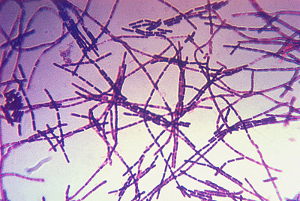
Participant List for NIMBioS Working Group:
Modeling Low Dose Exposure to Inhalation Anthrax
| Participant | Affiliation | Expertise | Meetings |
|---|---|---|---|
| Judy Day | Univ. of Tennessee, Dept. of Mathematics | Mathematics (Mathematical modeling of host response to infectious diseases) | 1,2,3 |
| Vitaly Ganusov | Univ. of Tennessee, Dept. of Microbiology | Biology (Mathematical modeling & data analysis) | 1,2,3 |
| Brad Gutting | U.S. Navy, Naval Surface Warfare Center Dahlgren Division | Toxicology (Immunology & Computational Biology) | 1 |
| Charles Haas | Drexel Univ., Environmental Engineering | Disinfection process models and process control | 2 |
| Philip Hanna | Univ. of Michigan Medical School, Dept. of Microbiology and Immunology | Microbiology (Bacillus anthracis pathogenesis, host responses to anthrax, and medical implications) | 1,2,3 |
| Judith A. Hewitt | Office of Biodefense Research Affairs, Division of Microbiology & Infectious Diseases; National Inst. of Allergy & Infectious Diseases; Chief, Biodefense Research Resources Section | Biochemistry (Developing animal models of anthrax disease to support development of countermeasures & therapeutics) | 1 |
| Hyang Mi Kim | Univ. of Calgary, Canada, Dept. of Mathematics & Statistics | Statistics (Methods for occupational & environmental exposure assessments) | 1,2,3 |
| Gesham Magombedze | NIMBioS | Mathematics (Mathematical modeling of infectious diseases) | 1,2 |
| Calistus Ngonghala | NIMBioS | Mathematical modeling, dynamics of disease transmission | 1,2 |
| Buddhi Pantha | Univ. of Tennessee, Dept. of Mathematics | Mathematics | 1,2,3 |
| Louise Pitt | United States Army Medical Research Inst. for Infectious Diseases (DOD); Center for Aerobiological Sciences (Director) | Aerobiology | 1 |
| Megan Powell | Lyon College, Math & Science Division | Mathematics (Mathematical modeling) | 1,2,3 |
| Conrad Quinn | Centers for Disease Control and Prevention, MPIR Laboratory (Chief) | Microbiology (Immunology and B. anthracis pathogenesis, anthrax vaccines, therapeutics and diagnostics) | 1 |
| Angela Reynolds | Virginia Commonwealth Univ., Dept. of Mathematics | Mathematics (ODE and PDE modeling of lung inflammation) | 1,2,3 |
| Harish Shankaran | Pacific Northwest National Lab | Computational Biology & Bioinformatics | 1,2,3 |
| Sarah Taft | US Environmental Protection Agency - National Homeland Security Research Center- Threat and Consequence Assessment Division | Microbiology (Applied Microbiology & Microbial Risk Assessment) | 1,2,3 |
| Justin Teeguarden | Battelle Memorial Inst., Pacific Northwest National Laboratory | Toxicology (Biological Monitoring & Modeling) | 1 |
Mtg 1: May 15-17, 2012
Mtg 2: November 13-15, 2012
Mtg 3: May 15-17, 2013
Updated 05/15/2013
NIMBioS
1122 Volunteer Blvd., Suite 106
University of Tennessee
Knoxville,
TN 37996-3410
PH: (865) 974-9334
FAX: (865) 974-9461
Contact NIMBioS
From 2008 until early 2021, NIMBioS was supported by the
National Science Foundation
through NSF Award #DBI-1300426, with additional support from
The University of Tennessee, Knoxville. Any opinions, findings, and conclusions or recommendations expressed in this material are those of the author(s) and do not necessarily reflect the views of the National Science Foundation.
©2008-2021 National Institute for Mathematical and Biological Synthesis. All rights reserved.


